Telescope Reviews, Page 7!
By Ed Ting
Updated 5/31/00
Astronomy Magazines in Japan
I get all kinds of interesting things in the mail from all over the world, but a
copy of a Japanese astronomy magazine, sent by a kind reader in Sapporo,
really got me going. Some observations:
The Japanese are totally nuts about equipment. That's supposed to be a
compliment. Imagine, a 300 page monthly with 150+ pages of ads each issue.
Like everything else in Japan, the ads are crowded. You'd need a magnify-
ing glass to read some of the copy. Refractors seem to be the hot item here,
followed by high-quality Newtonians (ie, the ubiquitous Vixen R200SS) with
SCTs running a distant third.
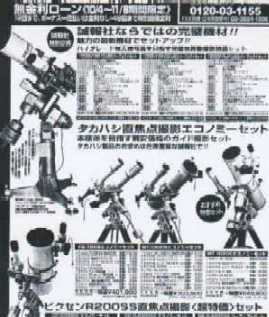 Way-cool Japanese refractor stuff
Imagine 150+ pages of this every month
The star charts in the fold-out section in the middle of the magazine are
really, and I mean, beautifully, drawn.
Guidescopes and large finders seem far more common in Japan than they
are here. You see a lot of those side-by-side mounting plates in use. It's
not uncommon to see a guidescope, a giant finder and a camera of some sort
in use simultaneously on the same rig. In fact, it seems as though the goal
of many Japanese is to see how much stuff you can pile onto a Great Polaris
without it toppling over!
I'm not sure what the pay scale is like in Japan, but there does seem to be
an abundance of really high-brow Takahashi, Pentax, Mizar, and Borg stuff for
sale. I could retire fat and happy with the stuff on these pages. Furthermore, I
think some US distributor and/or rep is really losing out by not importing some
of this stuff.
Oh yeah -- there are some astronomy articles in the magazine, too -- wish
I could read 'em!
Way-cool Japanese refractor stuff
Imagine 150+ pages of this every month
The star charts in the fold-out section in the middle of the magazine are
really, and I mean, beautifully, drawn.
Guidescopes and large finders seem far more common in Japan than they
are here. You see a lot of those side-by-side mounting plates in use. It's
not uncommon to see a guidescope, a giant finder and a camera of some sort
in use simultaneously on the same rig. In fact, it seems as though the goal
of many Japanese is to see how much stuff you can pile onto a Great Polaris
without it toppling over!
I'm not sure what the pay scale is like in Japan, but there does seem to be
an abundance of really high-brow Takahashi, Pentax, Mizar, and Borg stuff for
sale. I could retire fat and happy with the stuff on these pages. Furthermore, I
think some US distributor and/or rep is really losing out by not importing some
of this stuff.
Oh yeah -- there are some astronomy articles in the magazine, too -- wish
I could read 'em!
Click on a scope below:
Takahashi Epsilon 200
Meade 102APO/500
DGM Optics 5.5 Off-Axis Newtonian
Takahashi FC100
1) Takahashi Epsilon 200
(8" f/4 Hyperbolic Astrograph, OTA only, NLA, replaced by Epsilon 210 $6295)
This is the best 8" reflector I've ever seen, and one of the best Newtonians
I've looked through, period. This unit -apparenly an older version made in
1990- arrived from Japan in good condition, although its collimation was off
a bit. A little tweaking on the secondary straightened things out nicely.
This telescope is massive. The oversized tube, coupled with all of that cast
iron, made it too much for the GM-8. The owner wound up mounting the scope
on his AP900. This is not your father's Vixen R200SS.
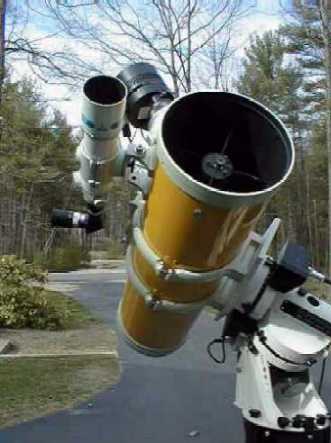 Takahashi Epsilon 200 on an AP900 mount
Note the FC50 and ST-8 CCD camera
The Epsilon is billed as an astrograph, but there's nothing stopping you from
putting an eyepiece into the focuser. However, the extremely short focus travel
will limit the eyepieces you can use. None of the TeleVues I had on hand
would focus unless I "boosted" them up about 1/2" and held them in with the
focus lock knob.
We removed the huge field flattener - a very serious hunk of glass - from the
focuser during collimation. A daytime star test on a distant point of light re-
vealed modest overcorrection, surprising for a telescope of this lineage. Then,
we remembered that the objective on this scope is hyperbolic, which will tend
to show overcorrection. The scope is designed to be used with the field flattener
installed, so we replaced it. Once this was done, most of the spherical aberra-
tion went away. Neat.
The views were excellent. Stars were pinpoints all the way out to the field
stop, with almost no contrast loss at the edges of the FOV. This is an
incredibly impressive acheivement for a mirror operating at f/4. Six stars
were visible with direct vision in the Trapezium. On deep sky objects, con-
trast is extremely good, even with the relatively large central obstruction.
For comparison, the scope was placed alongside the Orion (UK) Europa 8"
f/4 Schmidt-Newtonian. Although the Europa has the identical aperture and
focal length, there was no contest at all. The Takahashi refused to allow
stars to be anything other than pinpoints, while the Europa tended to stretch
stars out to long arcs near the field stop.
As the evening wore on, I found myself treating the Epsilon more like a 10" or
a 12" scope, rather than an 8". I found NGC4036/NGC4041, and the NGC3190
group in Leo -- things I would not normally ask an 8" to do. What's more, the
owner had mounted an FC50 as a guide scope, which means I was getting
superb views no matter where I looked on this telescope. Ah, luxury!
The Epsilon 200 is a great photographic tool that can easily double as a
stunning wide field deep-sky scope. This model is no longer available; it's
been replaced by the f/3 (yes, f/3) Epsilon 210 ($6295.) Recommeded to
those lucky enough to afford one.
2) Meade 102APO/500
(102 mm f/9 doublet ED apochromat, 8X50 finder, 26 mm Plossl, LXD500 mount,
2" diagonal, $1695, also available with LXD650 mount, drives, etc for $2795)
(Note: see also reviews of the 6" 152ED and 7" 178ED models in this series)
Selling for up to $1000 less than comparable 4" apochromatic refractors,
these 4" ED scopes from Meade would seem to be just the ticket for
quality-minded observers on a budget. In fact, I have been tempted on
many occasions to order one myself. So, when Mike (who also owns
the 178ED reviewed elsewhere on this web site) finally bought one, I was
intrigued, and very anxious to check it out.
Takahashi Epsilon 200 on an AP900 mount
Note the FC50 and ST-8 CCD camera
The Epsilon is billed as an astrograph, but there's nothing stopping you from
putting an eyepiece into the focuser. However, the extremely short focus travel
will limit the eyepieces you can use. None of the TeleVues I had on hand
would focus unless I "boosted" them up about 1/2" and held them in with the
focus lock knob.
We removed the huge field flattener - a very serious hunk of glass - from the
focuser during collimation. A daytime star test on a distant point of light re-
vealed modest overcorrection, surprising for a telescope of this lineage. Then,
we remembered that the objective on this scope is hyperbolic, which will tend
to show overcorrection. The scope is designed to be used with the field flattener
installed, so we replaced it. Once this was done, most of the spherical aberra-
tion went away. Neat.
The views were excellent. Stars were pinpoints all the way out to the field
stop, with almost no contrast loss at the edges of the FOV. This is an
incredibly impressive acheivement for a mirror operating at f/4. Six stars
were visible with direct vision in the Trapezium. On deep sky objects, con-
trast is extremely good, even with the relatively large central obstruction.
For comparison, the scope was placed alongside the Orion (UK) Europa 8"
f/4 Schmidt-Newtonian. Although the Europa has the identical aperture and
focal length, there was no contest at all. The Takahashi refused to allow
stars to be anything other than pinpoints, while the Europa tended to stretch
stars out to long arcs near the field stop.
As the evening wore on, I found myself treating the Epsilon more like a 10" or
a 12" scope, rather than an 8". I found NGC4036/NGC4041, and the NGC3190
group in Leo -- things I would not normally ask an 8" to do. What's more, the
owner had mounted an FC50 as a guide scope, which means I was getting
superb views no matter where I looked on this telescope. Ah, luxury!
The Epsilon 200 is a great photographic tool that can easily double as a
stunning wide field deep-sky scope. This model is no longer available; it's
been replaced by the f/3 (yes, f/3) Epsilon 210 ($6295.) Recommeded to
those lucky enough to afford one.
2) Meade 102APO/500
(102 mm f/9 doublet ED apochromat, 8X50 finder, 26 mm Plossl, LXD500 mount,
2" diagonal, $1695, also available with LXD650 mount, drives, etc for $2795)
(Note: see also reviews of the 6" 152ED and 7" 178ED models in this series)
Selling for up to $1000 less than comparable 4" apochromatic refractors,
these 4" ED scopes from Meade would seem to be just the ticket for
quality-minded observers on a budget. In fact, I have been tempted on
many occasions to order one myself. So, when Mike (who also owns
the 178ED reviewed elsewhere on this web site) finally bought one, I was
intrigued, and very anxious to check it out.
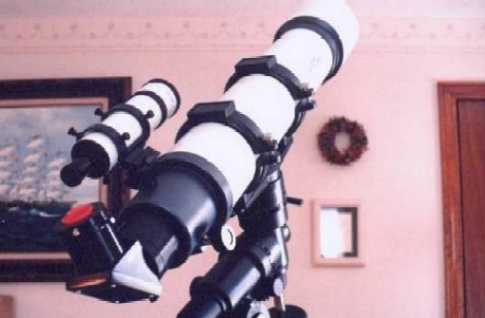 Great Expectations: Meade's 102APO/500
As with many other Meade scopes, this one's a real looker. Just seeing
it set up in the living room makes you want to use it. The telescope
has a lean and mean look to it, tastefully accented with battleship-gray
metal pieces. The huge focuser and finder let you know the scope means
business.
There is flexure in the equatorial head that even with all of the screws
and locks tightened down, I could still easily induce a two degree movement
in any direction by gently leaning on the diagonal. There is a modest amount
of take-up slop in the slow motion controls, which makes manual tracking at
high power frustrating. What's more, if you tighten the linkages to eliminate
the slop, the knobs become stiff and hard-to-turn.
The mount is supplied with two counterweights, which is way too much
weight for the equatorial head. The views jiggled and wiggled, until
we removed one of the weights. Even then, the mount is rather unsteady.
Finally, Meade still uses non-captive bolts on its rings, which invites you
to lose them. Readers should note that we experienced similar problems
with another LXD500 on the Meade 102ACHR/500.
All of this might be tolerable if the optics were good, but there were
concerns in this arena as well. The star test was a mess. The optics
are undercorrected, astigmatic, and the elements appear decentered. I
also noted pear-shaped diffraction rings, and suggested to Mike that the
optics might be pinched.
We removed the tube and did a quick squaring-on of the objective. Sure
enough, the lens had been aggressively tightened against the lens cell
from the factory (there was a squeaky popping noise as one of the lens
cell's allen bolts finally gave way.) Once squared-on, the images improved,
but the optics are still astigmatic, and it is difficult to draw a fine focus.
Bright objects look comet-like, with a flare extending out one end. These
problems are suspiciously like the ones we experienced on Mike's 178ED.
The scope shows a trace of false color. It is visible as a dim purple ring
around bright point-source objects like Capella at powers over 100X. I could
still see color around the two components of Castor. However, the color is
dim and relatively benign in shade, and I think you'd have to be a real
curmudgeon to be bothered by it.
Great Expectations: Meade's 102APO/500
As with many other Meade scopes, this one's a real looker. Just seeing
it set up in the living room makes you want to use it. The telescope
has a lean and mean look to it, tastefully accented with battleship-gray
metal pieces. The huge focuser and finder let you know the scope means
business.
There is flexure in the equatorial head that even with all of the screws
and locks tightened down, I could still easily induce a two degree movement
in any direction by gently leaning on the diagonal. There is a modest amount
of take-up slop in the slow motion controls, which makes manual tracking at
high power frustrating. What's more, if you tighten the linkages to eliminate
the slop, the knobs become stiff and hard-to-turn.
The mount is supplied with two counterweights, which is way too much
weight for the equatorial head. The views jiggled and wiggled, until
we removed one of the weights. Even then, the mount is rather unsteady.
Finally, Meade still uses non-captive bolts on its rings, which invites you
to lose them. Readers should note that we experienced similar problems
with another LXD500 on the Meade 102ACHR/500.
All of this might be tolerable if the optics were good, but there were
concerns in this arena as well. The star test was a mess. The optics
are undercorrected, astigmatic, and the elements appear decentered. I
also noted pear-shaped diffraction rings, and suggested to Mike that the
optics might be pinched.
We removed the tube and did a quick squaring-on of the objective. Sure
enough, the lens had been aggressively tightened against the lens cell
from the factory (there was a squeaky popping noise as one of the lens
cell's allen bolts finally gave way.) Once squared-on, the images improved,
but the optics are still astigmatic, and it is difficult to draw a fine focus.
Bright objects look comet-like, with a flare extending out one end. These
problems are suspiciously like the ones we experienced on Mike's 178ED.
The scope shows a trace of false color. It is visible as a dim purple ring
around bright point-source objects like Capella at powers over 100X. I could
still see color around the two components of Castor. However, the color is
dim and relatively benign in shade, and I think you'd have to be a real
curmudgeon to be bothered by it.
 Too Lightweight: The LXD500 Mount
For comparison, we dragged out one of our Celestron C102HD achromats
($599 -- Mike and I each own one.) The Meade exhibited less false color
and had darker backgrounds, but the C102HD was sharper. Castor was
split at 80X in the C102HD, while we could never really obtain a clean split,
at any magnification, on the Meade.
On deep sky, the Meade did better, due to its inherently higher contrast.
M81/M82, M37, and NGC2903 were a bit better in the Meade. Stars were
brighter and the skies darker in the 102APO. However, as soon as a bright
object entered the field of view in the Meade, the scope would spray its
light into a spiked, comma-shaped blob.
I feel it's fair to point out that I have received reliable reports of some very
good Meade 102APOs out there. However, this unit did leave the Meade
factory, presumably had passed QC, and was intended for public consumption.
It is not unreasonable to think that there may be others out there in a similar
condition.
Mike used the scope during our club's Messier Marathon on 3/20/99, and
reported good results. I wandered over several times during the course of the
evening and verified this. The Meade's impressive contrast made short work of
difficult areas like the Virgo Cluster, but its images of Mars were less encourag-
ing (bright objects still bother the scope.)
To say I'm disappointed is an understatement. Perhaps it's because my
expectations were so high -- I really wanted to like this scope. I will also
seek out another sample (anyone in the area want to volunteer theirs for a
couple of days?) for a second opinion.
Should the situation with this sample change, you will be the first to know.
Keep checking this space. For you, dear reader, I'd urge caution, and a
personal audition, before purchasing one of these telescopes. I would also
strongly suggest that you forego the LXD500-mounted version -- either buy
the OTA and mount it on a Super Polaris-class mount, or get the full-boat
LXD650 treatment (Note: I haven't seen the scope advertised lately on the
LXD500 mount, so this configuration may be NLA.) Also, it is mandatory
to deal with a seller who will work with you, should things turn out to be
less than what you expected.
Postscript 3/22/99: Mike spoke with Meade about the problems with this
particular 102APO. Meade apologized profusely, issued a return call-tag #,
and is sending out another tube. While Meade's prompt customer service is
encouraging, it is sobering to think that 6 out of the last 8 Meade refractors
we've tested (2 out of 3 178EDs, 3 out of 4 102ACHR/500s, and this one)
have been less than stellar. Stay tuned.
Postscript 4/30/99: Much better! Meade returned the tube about 4 weeks
later, and this sample is excellent. Speherical aberration is virtually non-
existent, the astigmatism is gone, and this unit has almost no false color.
We spent an enjoyable (albeit short) evening splitting doubles and looking
at Mars, which was just past opposition.
I am often asked by readers if they should purchase these Meade ED refractors.
You may be surprised to learn, my answer is usually "yes" -- provided they
do so from a reputable dealer. At their best, these Meade APOs are capable
of near world-class performance, and they cost a lot less than the "luxury"
brands. However, as we have seen, the quality can vary quite a bit from
sample to sample. You may have to be somewhat patient before you get a
good one. It is important to work with a good dealer, should you need to seek
recourse.
3) DGM Optics 5.5" Off-Axis Newtonian
(5.5" f/10 Off-Axis Dobsonian, $1375-$1675, depending on tube material)
I first saw one of Dan McShane's off-axis telescopes at Stellafane. Initial
views looked very promising. As it turns out, McShane and I live only about
40 miles apart, so I arranged to take delivery of a review sample through
a third party.
Too Lightweight: The LXD500 Mount
For comparison, we dragged out one of our Celestron C102HD achromats
($599 -- Mike and I each own one.) The Meade exhibited less false color
and had darker backgrounds, but the C102HD was sharper. Castor was
split at 80X in the C102HD, while we could never really obtain a clean split,
at any magnification, on the Meade.
On deep sky, the Meade did better, due to its inherently higher contrast.
M81/M82, M37, and NGC2903 were a bit better in the Meade. Stars were
brighter and the skies darker in the 102APO. However, as soon as a bright
object entered the field of view in the Meade, the scope would spray its
light into a spiked, comma-shaped blob.
I feel it's fair to point out that I have received reliable reports of some very
good Meade 102APOs out there. However, this unit did leave the Meade
factory, presumably had passed QC, and was intended for public consumption.
It is not unreasonable to think that there may be others out there in a similar
condition.
Mike used the scope during our club's Messier Marathon on 3/20/99, and
reported good results. I wandered over several times during the course of the
evening and verified this. The Meade's impressive contrast made short work of
difficult areas like the Virgo Cluster, but its images of Mars were less encourag-
ing (bright objects still bother the scope.)
To say I'm disappointed is an understatement. Perhaps it's because my
expectations were so high -- I really wanted to like this scope. I will also
seek out another sample (anyone in the area want to volunteer theirs for a
couple of days?) for a second opinion.
Should the situation with this sample change, you will be the first to know.
Keep checking this space. For you, dear reader, I'd urge caution, and a
personal audition, before purchasing one of these telescopes. I would also
strongly suggest that you forego the LXD500-mounted version -- either buy
the OTA and mount it on a Super Polaris-class mount, or get the full-boat
LXD650 treatment (Note: I haven't seen the scope advertised lately on the
LXD500 mount, so this configuration may be NLA.) Also, it is mandatory
to deal with a seller who will work with you, should things turn out to be
less than what you expected.
Postscript 3/22/99: Mike spoke with Meade about the problems with this
particular 102APO. Meade apologized profusely, issued a return call-tag #,
and is sending out another tube. While Meade's prompt customer service is
encouraging, it is sobering to think that 6 out of the last 8 Meade refractors
we've tested (2 out of 3 178EDs, 3 out of 4 102ACHR/500s, and this one)
have been less than stellar. Stay tuned.
Postscript 4/30/99: Much better! Meade returned the tube about 4 weeks
later, and this sample is excellent. Speherical aberration is virtually non-
existent, the astigmatism is gone, and this unit has almost no false color.
We spent an enjoyable (albeit short) evening splitting doubles and looking
at Mars, which was just past opposition.
I am often asked by readers if they should purchase these Meade ED refractors.
You may be surprised to learn, my answer is usually "yes" -- provided they
do so from a reputable dealer. At their best, these Meade APOs are capable
of near world-class performance, and they cost a lot less than the "luxury"
brands. However, as we have seen, the quality can vary quite a bit from
sample to sample. You may have to be somewhat patient before you get a
good one. It is important to work with a good dealer, should you need to seek
recourse.
3) DGM Optics 5.5" Off-Axis Newtonian
(5.5" f/10 Off-Axis Dobsonian, $1375-$1675, depending on tube material)
I first saw one of Dan McShane's off-axis telescopes at Stellafane. Initial
views looked very promising. As it turns out, McShane and I live only about
40 miles apart, so I arranged to take delivery of a review sample through
a third party.
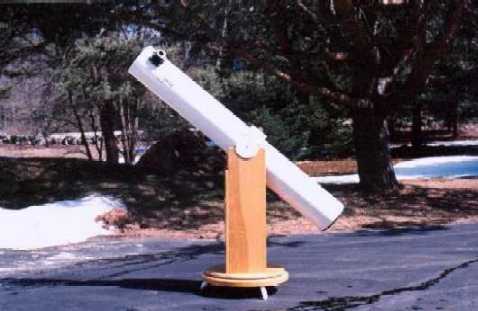 The 5.5" f/10 Off-Axis Newtonian
Compared to good refractors, Newtonians exhibit lower contrast and a slight
loss of sharpness. This is due to a number of factors, including inefficient
reflectivity of its mirrors, inadequate alignment of optics (miscollimation),
thermal effects near the tube, and the central obstruction. All of these
effects are important, but of them, the central obstruction gets the most
blame by far, because it's the most "visible" of the faults. What if it were
possible to build a Newtonian without a central obstruction?
Those of you who own large-aperture Dobsonians often stop down the objective
with a mask. The mask allows a longer f/ratio, penetrates bad seeing more
efficiently, and you can position it between the secondary vanes to eliminate
those annoying diffraction spikes.
This is, in fact, exactly how an off-axis Newtonian works. McShane's mirrors
are cut, like a cookie cutter, out of a larger "parent" mirror. If done correct-
ly, one parent mirror can yield as many as four smaller off-axis mirrors. This
is not as easy as it sounds. First, you have to locate an exceptional mirror
of 16" or so in diameter. Then, you need the skill to cut them without stress-
ing the glass.
The scope is extremely well-made. The woodworking is furniture-grade, about
at the level of, say, the 7" Starmaster. Also, the tube is available in either
aluminum or fiberglass, which is a step above the Sonotube you usually
find on Dobsonians. The cradle allows you to rotate the tube. The altitude
bearings are made of solid UHMW, a polymer with similar characteristics to
teflon. The three beefy, spiked legs are also made of the same material.
The scope is sold finderless. McShane assumes (correctly, I think) that
anyone shopping for a telescope like this probably has some pretty strong
ideas about what constitutes an acceptable finder. For myself, I mounted
my Rigel Quik Point at the front end of the tube. Also, the scope comes
with a helical focuser. Think twice before replacing it with a rack-and-
pinion unit. The secondary mirror lies right below the focuser's drawtube,
and you have to be absolutely sure that the drawtube will not extend
below the plane of the scope's tube.
The 5.5" f/10 Off-Axis Newtonian
Compared to good refractors, Newtonians exhibit lower contrast and a slight
loss of sharpness. This is due to a number of factors, including inefficient
reflectivity of its mirrors, inadequate alignment of optics (miscollimation),
thermal effects near the tube, and the central obstruction. All of these
effects are important, but of them, the central obstruction gets the most
blame by far, because it's the most "visible" of the faults. What if it were
possible to build a Newtonian without a central obstruction?
Those of you who own large-aperture Dobsonians often stop down the objective
with a mask. The mask allows a longer f/ratio, penetrates bad seeing more
efficiently, and you can position it between the secondary vanes to eliminate
those annoying diffraction spikes.
This is, in fact, exactly how an off-axis Newtonian works. McShane's mirrors
are cut, like a cookie cutter, out of a larger "parent" mirror. If done correct-
ly, one parent mirror can yield as many as four smaller off-axis mirrors. This
is not as easy as it sounds. First, you have to locate an exceptional mirror
of 16" or so in diameter. Then, you need the skill to cut them without stress-
ing the glass.
The scope is extremely well-made. The woodworking is furniture-grade, about
at the level of, say, the 7" Starmaster. Also, the tube is available in either
aluminum or fiberglass, which is a step above the Sonotube you usually
find on Dobsonians. The cradle allows you to rotate the tube. The altitude
bearings are made of solid UHMW, a polymer with similar characteristics to
teflon. The three beefy, spiked legs are also made of the same material.
The scope is sold finderless. McShane assumes (correctly, I think) that
anyone shopping for a telescope like this probably has some pretty strong
ideas about what constitutes an acceptable finder. For myself, I mounted
my Rigel Quik Point at the front end of the tube. Also, the scope comes
with a helical focuser. Think twice before replacing it with a rack-and-
pinion unit. The secondary mirror lies right below the focuser's drawtube,
and you have to be absolutely sure that the drawtube will not extend
below the plane of the scope's tube.
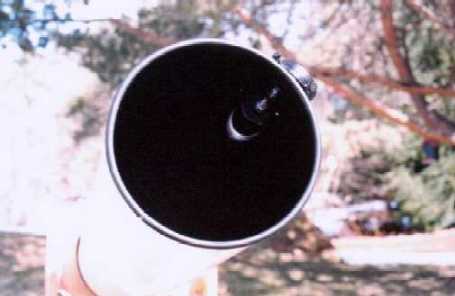 Looking inside the tube. Note the location of the secondary.
I will admit something right here: I was skeptical about all of this. I con-
sidered this a gimmick. It is not. The scope gives absolutely wonderful
views. The star test resembled that of a good refractor -- clean and sym-
metrical. The contrast was very high. As an "acid test", I toured the
Messier galaxies in Virgo with the 1st quarter moon about 70 degrees away.
For comparison, I dragged out my trusty Meade 6" Starfinder Dobsonian.
While the 6" found all of the galaxies, the contrast on the DGM was in
another league. It's as if someone "erased" half of the moon. The
gains in contrast meant that I could pick out smaller galaxies in the
Markarian's Chain region that were barely visible in the Meade. Indeed,
all objects were brighter in the 5.5" than in the 6". When I spoke with
McShane about this, he said that the lack of the central obstruction
and the enhanced coatings on his scope puts the effective light-gathering
ability of the DGM somewhere between a 6" and 8" scope from a "con-
ventional" manufacturer.
By the way, these remarks should not be taken as disparaging towards
the Meade -- the 6" Starfinder is a very good telescope by any objective
measure (except for the all-plastic 2" focuser, which is starting to give
me some problems) and a fine value. It's recommended to beginners
and advanced observers alike.
Drawbacks? The scope's tall, narrow profile makes it a little unsteady
in the wind. If you're shorter than about 5" 7", you may have to stand
on tiptoes to reach the eyepiece near the zenith. As with any Dob,
tracking by hand over 150X or so is a bit of a pain. I'm not too thrilled
with any helical focuser. I understand the need to protect the secondary,
but perhaps a mechanical stop of some kind can be rigged to the scope,
to prevent the drawtube from impacting the mirror. Finally, you are going
to have to re-learn some of what you know about collimation.
These concerns are minor, of course. The DGM is a great alternative
to Dobsonian fans looking for something upscale, but on a middle-class
budget. Recommended.
4) Takahashi FC100
(100 mm f/8 fluorite doublet apochromat, OTA only, NLA, about $1800-$2000
used)
"What is the sound of one hand clapping?"
"If a tree falls in the forest and no one hears it, does it still make a
noise?"
"How does the Takahashi company continue to turn out these perfect little
telescopes, one right after the other?"
Ah, the mysteries of life! These older scopes show up quite a bit on the
used market, and pre-date the current FS102 units by a few years. The
major difference, other the the 2 mm added to the new versions, is that
these FC units still have the fluorite element in the rear (newer FS units
have the fluorite element in front.)
Looking inside the tube. Note the location of the secondary.
I will admit something right here: I was skeptical about all of this. I con-
sidered this a gimmick. It is not. The scope gives absolutely wonderful
views. The star test resembled that of a good refractor -- clean and sym-
metrical. The contrast was very high. As an "acid test", I toured the
Messier galaxies in Virgo with the 1st quarter moon about 70 degrees away.
For comparison, I dragged out my trusty Meade 6" Starfinder Dobsonian.
While the 6" found all of the galaxies, the contrast on the DGM was in
another league. It's as if someone "erased" half of the moon. The
gains in contrast meant that I could pick out smaller galaxies in the
Markarian's Chain region that were barely visible in the Meade. Indeed,
all objects were brighter in the 5.5" than in the 6". When I spoke with
McShane about this, he said that the lack of the central obstruction
and the enhanced coatings on his scope puts the effective light-gathering
ability of the DGM somewhere between a 6" and 8" scope from a "con-
ventional" manufacturer.
By the way, these remarks should not be taken as disparaging towards
the Meade -- the 6" Starfinder is a very good telescope by any objective
measure (except for the all-plastic 2" focuser, which is starting to give
me some problems) and a fine value. It's recommended to beginners
and advanced observers alike.
Drawbacks? The scope's tall, narrow profile makes it a little unsteady
in the wind. If you're shorter than about 5" 7", you may have to stand
on tiptoes to reach the eyepiece near the zenith. As with any Dob,
tracking by hand over 150X or so is a bit of a pain. I'm not too thrilled
with any helical focuser. I understand the need to protect the secondary,
but perhaps a mechanical stop of some kind can be rigged to the scope,
to prevent the drawtube from impacting the mirror. Finally, you are going
to have to re-learn some of what you know about collimation.
These concerns are minor, of course. The DGM is a great alternative
to Dobsonian fans looking for something upscale, but on a middle-class
budget. Recommended.
4) Takahashi FC100
(100 mm f/8 fluorite doublet apochromat, OTA only, NLA, about $1800-$2000
used)
"What is the sound of one hand clapping?"
"If a tree falls in the forest and no one hears it, does it still make a
noise?"
"How does the Takahashi company continue to turn out these perfect little
telescopes, one right after the other?"
Ah, the mysteries of life! These older scopes show up quite a bit on the
used market, and pre-date the current FS102 units by a few years. The
major difference, other the the 2 mm added to the new versions, is that
these FC units still have the fluorite element in the rear (newer FS units
have the fluorite element in front.)
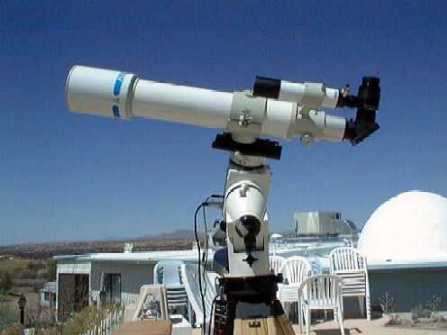 The FC100 on the AP600 mount
This scope has no spherical aberration at all, but does show a tiny
trace of false color, which is a bit more pronounced than on my FS102.
In focus, however, I had a very hard time detecting any false color at
all on Sirius of the limb of the moon.
In any case, this is hair-splitting -- the FC100 delivers knock-your-
socks-off views of both planets and the brighter deep sky objects.
M93, M42, M81/M82, M51, etc were splendid, and the stellar images
were perfect little pinpoints against a velvet black sky. Seeing fam-
iliar objects like M35/M36/M37/M38, etc with this scope and a 20 mm
Nagler is enough to make you forget all about equipment, for a while.
Wonderful scope. Keep in mind, the price of admission may or may
not include the finder, diagonal, or the tube ring, so these scopes
can get expensive mighty fast. Clarify before sending your check.
FC100s are technically no longer available; they've been replaced
by the FS102. Now, start browsing those classifieds!
End Telescope Reviews, Page 7
The FC100 on the AP600 mount
This scope has no spherical aberration at all, but does show a tiny
trace of false color, which is a bit more pronounced than on my FS102.
In focus, however, I had a very hard time detecting any false color at
all on Sirius of the limb of the moon.
In any case, this is hair-splitting -- the FC100 delivers knock-your-
socks-off views of both planets and the brighter deep sky objects.
M93, M42, M81/M82, M51, etc were splendid, and the stellar images
were perfect little pinpoints against a velvet black sky. Seeing fam-
iliar objects like M35/M36/M37/M38, etc with this scope and a 20 mm
Nagler is enough to make you forget all about equipment, for a while.
Wonderful scope. Keep in mind, the price of admission may or may
not include the finder, diagonal, or the tube ring, so these scopes
can get expensive mighty fast. Clarify before sending your check.
FC100s are technically no longer available; they've been replaced
by the FS102. Now, start browsing those classifieds!
End Telescope Reviews, Page 7
Back to Home Page
 Way-cool Japanese refractor stuff
Imagine 150+ pages of this every month
Way-cool Japanese refractor stuff
Imagine 150+ pages of this every month Way-cool Japanese refractor stuff
Imagine 150+ pages of this every month
Way-cool Japanese refractor stuff
Imagine 150+ pages of this every month Takahashi Epsilon 200 on an AP900 mount
Note the FC50 and ST-8 CCD camera
Takahashi Epsilon 200 on an AP900 mount
Note the FC50 and ST-8 CCD camera Great Expectations: Meade's 102APO/500
Great Expectations: Meade's 102APO/500 Too Lightweight: The LXD500 Mount
Too Lightweight: The LXD500 Mount The 5.5" f/10 Off-Axis Newtonian
The 5.5" f/10 Off-Axis Newtonian Looking inside the tube. Note the location of the secondary.
Looking inside the tube. Note the location of the secondary. The FC100 on the AP600 mount
The FC100 on the AP600 mount